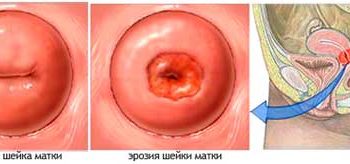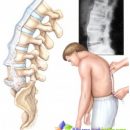Irregular menstruation are among young girls who are just beginning to menstruate, and in women approaching menopause. Menstruation irregularity is usually associated with ovulation, which can occur irregularly.
Content
Menstrual cycle
The menstrual cycle is cyclic changes in the body of a woman who are repeated with correct intervals (21-30 days) and externally manifested by regular uterine bleeding - menstruation (MENSES).
 Menstrual cycle includes a period of time from the first day of menstruation until the first day of the next menstruation. The most commonly observed a 28-day menstrual cycle equal to the lunar month. The duration of menstruation ranges from three to six days, and the amount of blood loss during one menstruation is 50 - 150 ml.
Menstrual cycle includes a period of time from the first day of menstruation until the first day of the next menstruation. The most commonly observed a 28-day menstrual cycle equal to the lunar month. The duration of menstruation ranges from three to six days, and the amount of blood loss during one menstruation is 50 - 150 ml.
In the overwhelming majority of menstruation cases, a characteristic complex of painful sensations is preceded: general malaise, increased fatigue, pulling pain in the lower back and the sacrum, etc. With very pronounced manifestations before menstruation, depriving a woman performance, it is customary to talk about premenstrual syndrome.
Menstrual function It is a very important indicator of the health of the woman, since in the regulation of the menstrual cycle, not only the function of the ovaries (female sex glands) plays a significant role, but also the normal operation of the endocrine and central nervous systems, as well as internal organs. Mental injuries, protracted stress, improper nutrition, leading, both to depletion and obesity, may cause a lamination of the menstrual cycle.
Very often, the impairment of the menstrual cycle is accompanied by infertility. At the occurrence of pregnancy against the background of disorders may be unbearable. Menstrual violations are found at any age.
Among the disorders of the menstrual cycle, the following are most common:
Amenorrhea
Amenorrhea - This is the absence of menstruation. Amenorrhea is called the absence of menstruation in an adult woman. Amenorrhea is not an independent disease, it is one of the symptoms of a number of diseases. Distinguish the following forms of amenorrhea.
True amenorrhea - This is the absence of menstruation caused by the presence of any changes in the system of organs carrying out the menstrual cycle. True amenorrhea is observed with a sharp shortage of sex hormones for the implementation of cyclic changes in endometrial (mucous membrane of the uterus).
False amenorrhea - This is the lack of release of menstrual blood in the presence of cyclic changes in the ovaries, the uterus and other organs. With false amenorrhea, the blood accumulates into the vagina, in the uterus and even the uterine pipes due to the presence of a mechanical obstacle (the infection of the virgin splava, the battle of the walls of the vagina and others.).
Primary amenorrhea - This is the situation when menstruation has a woman never.
Secondary amenorrhea - This is the situation when menstruation were, but then there was a cessation of menstruation for more than 3 months or forever.
Physiological amenorrhea - This is the absence of menstruation under a number of physiological states of the female organism: before the period of puberty; during pregnancy; Sometimes during breastfeeding period; In the period of menopause.
Artificially caused by Amenorrhea Observed after the removal of both ovaries or uterus.
Also allocate false amenorrhea. In this case, there is no outflow for menstrual blood due to malformations of the female sexual sphere. In this case, surgical treatment is necessary. Treatment of amenorrhea depends on the reason caused this condition.
Hymanstrual syndrome
This is a disruption of the menstrual cycle with a weakening of the menstrual function. Causes can be various chronic inflammatory diseases of the female genital sphere.
Distinguish:
- Hymenarya - blood loss during menstruation is very small (less than 25 ml.)
- Olygomenorea - shortening menstruation, often up to 1 - 2 days
- Obsenoria - the interval between the monthly becomes longer, more than 35 days
Often the woman has combinations of these violations. The factors leading to the weakening of menstruation are unfavorable living conditions, worsening the overall condition of the body, violating the function of the internal secretion glands, acute and chronic infectious diseases, intoxication and other factors that lead to the reduced function of the ovaries, and the reduced reproduction of sex hormones determine the insufficiency of blood circulation of the uterus and inferiority of cyclic conversion of endometrial.
Hypermenestrual syndrome
This is a disturbance of the menstrual cycle with the enhancement of menstrual function. The reasons are acute inflammatory diseases of the female genital sphere.
Distinguish:
- Hypermenorrhea – this is an increase in blood loss during menstruation
- Polymenorrhea – it is lengthening menstruation to more than seven days
- Promigatory – shortening intervals between menstruation
 This syndrome can lead to anemia (anemia). All pathological conditions under which the cutting capacity of the uterus is weakened and the processes of restoration of the uterine mucous membrane are violated, lead to an increase in bleeding and an increase in the duration of menstruation (hyperpolymenorrhea). Strengthening of menstrual bleeding promotes blood coagulation. The increase in menstruation with a reduction in menstrual cycles is observed in the inferiority of the main phases of the ovarian cycle.
This syndrome can lead to anemia (anemia). All pathological conditions under which the cutting capacity of the uterus is weakened and the processes of restoration of the uterine mucous membrane are violated, lead to an increase in bleeding and an increase in the duration of menstruation (hyperpolymenorrhea). Strengthening of menstrual bleeding promotes blood coagulation. The increase in menstruation with a reduction in menstrual cycles is observed in the inferiority of the main phases of the ovarian cycle.
Abundant and frequent menstruation may occur as a result of disorders of the function of the nervous system and pituitary gland coordinating the function of the ovaries. The common cause of prolonged, frequent and abundant menstruation is common diseases: diseases of the heart, liver, metabolic disorders, diseases of the thyroid and other endocrine glands, hypovitaminosis with, k, infectious diseases and intoxication, leading to changes in the walls of blood vessels, violation of the blood coagulation system, etc. Often, menorriage is observed in inflammatory diseases and anomalies of the position of the genital organs (pathological beggars, water loss), which is associated with inflammation, decrease in the contractile ability of the uterus and slowing the recovery shell. Hypermenstrual syndrome is often observed with the age-related ochniki hypofunction in the period of puberty (the formation of the ovaries function) and in the menobic period (the extinction of the ovarian function), as well as when the uterine fibromic. Hypermenorian is characterized by a more abundant than normal, menstrual bleeding, blood loss exceeds 200-300 ml; More often bleeding menstrual-like without blood clots. Menstrual cycle with hypermetry has a normal duration.
Treatment should be started with elimination of the cause of hyperendrement syndrome. Prolonged and abundant menstruation with uterine fibromomy are an indication for surgical treatment. In the hypofunction of the ovaries is carried out by a lining therapy, full nutrition, rational labor and recreation mode. In cases where the reasons are not installed and the menstrual cycle is not normalized, it is necessary to carry out hormonal treatment.
With massive menstruation shows urgent hospitalization.
Dysmenorrhea
It's sharply painful menstruation . The reasons are the redundant production of some hormones, which cause increased reduction in the uterus, and the causes of the region of the uterus may be causes.
Algodismenorye Or Menalgia (Menalgia) is a menstruation with a violation of general condition. With normal menstruation, most women have dismisses, more or less pronounced pain at the bottom of the abdomen and in the lower back, the general defeat, T.E. Premenstrual syndrome (Molimina Menstrualia), which is regarded as a physiological phenomenon.
Algomenorea It is customary to call painful menstruation. The pain at the same time is limited only by the sex apparatus of a woman (mainly by the uterus).
Menstruation with common painful phenomena (deterioration of well-being, disintegration, headache, nausea, vomiting, etc.) Called Dysmenoroei.
Menstruation with sharp malaise and various painful phenomena of local and general are called painful, or algodismenoreans, or menalgia.
Distinguish algodismenor primary and secondary. Primary observed in women from the first menstruation and is more often associated with any changes in the sex apparatus. In most cases, primary algodismenorrhea meets. Secondary algodismenorery develops as a result of some gynecological diseases (inflammatory diseases, endometriosis, tumors, etc.) or as a result of general reasons (preceding menstruation were painless).
Painful menstruations are a relatively frequent disorder of menstrual function and their manifestations are varied. Pain can accompany each menstruation, regularly appear every two menstruation or only with some menstrual bleeding. More often, pain occurs before the start of menstruation and continues during the first days of it, less often begins with menstruation and continues until its end, even less often the pain appears at the end of menstruation.
Most often, the pain of stupid, noving, is localized at the bottom of the abdomen and in the field of the sacrum, often wearing a grapple-shaped character, sometimes gives it to the thigh or to the rear passage area.
Of the general violations, the most commonly observed headache, often in the form of migraine, general weakness, malaise, depression, lack of appetite, nausea, vomiting, abundant salivation, constipation, sweating and other disorders, worsening the general condition and disability of a woman.
Algodismenorrhea is not an independent disease, but is a manifestation of other diseases, developmental anomalies or functional disorders.
The following factors play a major role in the origin of the Algodismenoria.
Psychogenic factor. Menstruation diseases contribute to various reasons that determine the increased irritability and instability of the nervous system: unfavorable environmental conditions, overwork, nervous shocks, developmental anomalies (infantilism), physique features (asthenia), mental illnesses (hysteria, schizophrenia), etc.
Mechanical obstacles, Comprehensive blood isolated from the uterine cavity: the narrowing of the cervical channel, sharp inflection of the uterus, cutting the narrowing of the cage of the uterus (after scraping and others.) - determine the overflow of the uterine cavity and the absorption of its walls, which, in turn, leads to an increased irritability of the edge wall receptors and causes a painful reaction. In addition, for expulsion from the oral uterus and the rejected functional layer of the epithelium in the presence of mechanical obstacles, more intensive cuts in the uterus are required, which are accompanied by painful sensations.
In the presence of mechanical obstacles, pain wears a local character (Algoromorian) and begins 1-2 days before menstruation. As soon as it becomes possible blood outflow, t. E. When menstruation began, pain decreases or completely disappears.
Endocrine factor. The cause of the painfulness of menstruation is also the physiological effect of ovarian hormones, especially the violation of hormonal (estrogen-progesterone) equilibrium.
Treatment in painful menstruation aims to eliminate the cause causeing pain. Self-treatment is unacceptable, since the treatment method is determined only by a qualified gynecologist after a survey and clarify the causes of algodismen. In case, it is necessary to rest, the reception of weakens of the means. Perhaps hormonal treatment, but it must be carried out depending on the hormonal saturation of the body, given the reason for dismensory.
With algodisotene, caused by inflammatory processes in the field of genital organs, it is necessary to be anti-inflammatory with subsequent physiotherapy and sanatorium-resort treatment.
To eliminate mechanical obstacles caused by congenital or acquired vices, surgical treatment is applied (operations that correct the position of the uterus, scraping the mucous membrane of the uterus) and gynecological massage.
Dysfunctional uterine bleeding
Women appear indiscriminate painless bleeding of various intensity. The general condition of a woman depends on the massiveness of bleeding. Such a violation can develop at any age. If the violation has arisen from a child, the reasons may be an unidentified function of ovarian or blood disease. In this case, carry out all the necessary surveys and prescribe hormonal therapy. If the violation arose in a woman of reproductive age, then the reasons may be acute inflammatory diseases of the female sexual sphere. In this case, anti-inflammatory therapy is assigned. If a violation occurs in a woman in menopause, it is regarded as suspicion of uterine cancer. In case of massive bleeding, an emergency hospitalization is shown.









